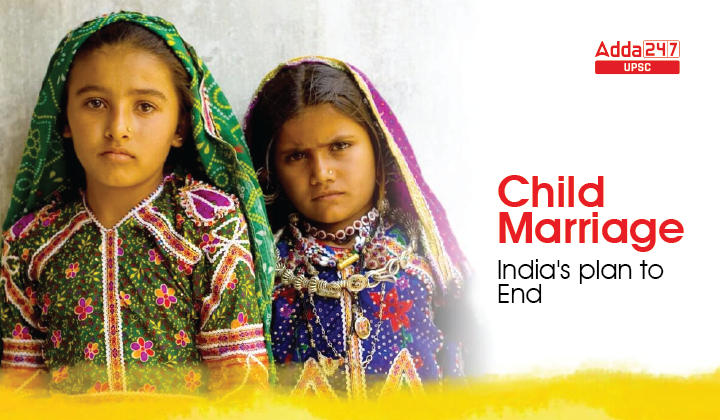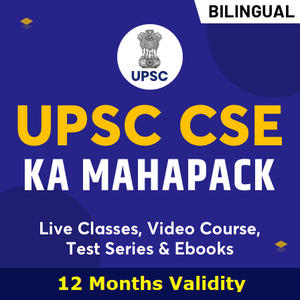Table of Contents
Child Marriage: India’s Plan to End
Relevance for UPSC Exam- General Studies II: Laws, Institutions & Bodies Constituted for The Vulnerable Sections
Child Marriage: India’s Plan to End- In News
The steering committee of a UNFPA-UNICEF Global Programme to End Child Marriage is on a visit to India to witness state interventions that have helped reduce the prevalence of child marriage.
- The UNFPA-UNICEF estimates that 10 million children could become child brides as a result of the pandemic globally.
What is Child Marriage?
- Child marriage refers to any formal marriage or informal union between a child under the age of 18 and an adult and another child.
- The Prohibition of Child Marriage (Amendment) Bill, 2021, fixes 21 years as the marriageable age for women.
Child Marriage: An overview
- A large proportion of child marriages take place primarily because of poverty and the burden of the huge costs of dowry associated with delayed marriages.
- It is because of social norms in many regions and cultures that parents begin preparations for a girl’s marriage once she has reached puberty.
- Conflict increases the inequalities that make girls vulnerable to child marriage – and its consequences. Families may arrange marriages for girls, believing marriage will protect their daughters from violence.
Child Marriage: Issues
- Globally, the prevalence of child marriage among boys is just one sixth that among girls.
- Child marriage robs girls of their childhood and threatens their lives and health.
- The practice can also isolate girls from family and friends and exclude them from participating in their communities, taking a heavy toll on their physical and psychological well-being.
- Girls who marry before 18 are more likely to experience domestic violence and less likely to remain in school.
- Child brides often become pregnant during adolescence, when the risk of mortality during for themselves and their infants.
- Girls are forced into adulthood before they are physically and mentally ready
- Child marriage negatively affects the Indian economy and can lead to an intergenerational cycle of poverty.
- Girls and boys married as children more likely lack the skills, knowledge and job prospects needed to lift their families out of poverty and contribute to their country’s social and economic growth.
Child Marriage: World Scenario
- According to data from UNICEF, the total number of girls married in childhood stands at 12 million per year.
- It strives to end the practice by 2030 — the target set out in the Sustainable Development Goals.
Child Marriage: India’s Plan to End
- There is a growing trend for a decline in the overall prevalence of child marriage.
- In India, child marriage reduced from 47.4% in 2005-06 to 26.8% in 2015-16, registering a decline of 21% points during the decade.
- In the last five years, it declined by 3.5% points to reach 23.3% in 2020-21, according to the latest National Family Health Survey-5 data.
- However, 3% is still a disturbingly high percentage in a country with a population of 141.2 crore.
- Some states have a higher prevalence than the national average — West Bengal, Bihar and Tripura top the list with more than 40% of women aged 20-24 years married below 18 (NFHS).
- In Kerala, women who got married before the age of 18 stood at 6.3% in 2019-20, from 7.6% in 2015-16.
Child Marriage: Laws in India
There are crucial laws that aim at protecting children from violation of human and other rights including the-
- Prohibition of Child Marriage Act, 2006 and
- Protection of Children from Sexual Offences Act, 2012
- A parliamentary standing committee is weighing the pros and cons of raising the age of marriage for women to 21, which has been cleared by the Union Cabinet.
- Beti Bachao Beti Padhao Scheme: It aims to address the issue of the declining child sex ratio image (CSR).
- Kanyashree scheme: West Bengal’s scheme offers financial aid to girls wanting to pursue higher studies.
- Bihar and other States have been implementing a cycle scheme to ensure girls reach safely to school, and UP has a scheme to encourage girls to go back to school.
Child Marriage: Way forward
- Much of the benefits can be reaped by ensuring that women complete education at least up to 12 years.
- Bangladesh shows that improving women’s education and imparting modern skills to them that increase their employability reduces child marriage and improves health and nutrition.
- Schemes which ease the financial burden of marriage but the eligibility criteria of which should essentially link to educational attainment in addition to age demand attention.
- A legalistic approach to increasing the age at marriage will produce positive results only if it leads to an improvement in women’s education and skill acquisition for employability.
- In the absence of an enhancement in women’s schooling or skills, a legalistic approach to ending child marriage might become counterproductive.




 TSPSC Group 1 Question Paper 2024, Downl...
TSPSC Group 1 Question Paper 2024, Downl...
 TSPSC Group 1 Answer key 2024 Out, Downl...
TSPSC Group 1 Answer key 2024 Out, Downl...
 UPSC Prelims 2024 Question Paper, Downlo...
UPSC Prelims 2024 Question Paper, Downlo...





